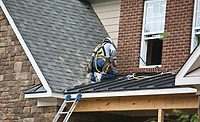A new tool can be a simple replacement or a re-invention. While pondering the purchase of a portable roll former can take more time than a shingle hatchet, some of them eventually become favorites. Sure, you don’t want the other tools to get jealous, but deep down each roofing contractor has come across more than innovation that had them instantly enamored.
Blade Runner
Andy Settimi has a favorite tool, but he’s not so sure he wants his competitors to know about it. In fact, after he bought two Rapid Roof Removers last year, he was concerned other contractors around town would see how productive he is. Settimi, president of Settimi-Fetters Roofing LLC in Loves Park, Ill., admits he never would have bought one if he didn’t see the shingle removing machine in action, but once he did it was love at first sight.
“I had three guys next to me and they couldn’t keep up,” he said about a recent competition among his crews. “That did surprise me. I was incredibly skeptical, but we tore off over 220 tons with those things.”
The Rapid Roof Remover uses a pneumatic blade that lifts the shingles from the deck just by pushing a lever. No more bending over to tear off several layers of shingles, probably the least favorite job of any steep-slope roofer. The process is so much faster that Settimi has changed how he approaches a job. Instead of spending most of the day tearing off, drying in a house and then shingling the next day, he can usually finish the job in one day.
“The guys shingle right behind them,” he said. “It’s made things a whole lot faster.”
Tool Hoarder
Wayne Phillips has witnessed a lot of creativity in equipment during his 20 years in the roofing business. The general superintendent for Mid-South of Forest Park, Ga., is seeing bigger motors, more hydraulics and belt-drives, and easier maintenance, but the most versatile tools he owns are husky four-wheel buggies from Reeves Equipment that take loads of abuse. The big tires don’t tear up roofs and spread out the weight evenly, while carrying debris and materials with ease.
While he doesn’t put on his old tool belt much, Phillips does have a collection of tools that the crews often access. In addition to metal and wood rollers that are still in service, his screw guns, some quite old, are a source of teasing.
“Every now and then I give one to some of the guys and they say, ‘How long have you had that?’” he laughs. “I’ve got a bunch of stuff in my shop at my house that I’ve had forever. I’m like a hoarder.”
Safety in Numbers
David Klein made sure he loved his new piece of equipment before he made the investment. Klein, president of Greenwood Industries, based in Millbury, Mass., saw a demonstration of Turbo-Rail, then had his crew try out the new safety rail system from Garlock Safety Systems before using it on all his jobs.
“It’s easy and fast to set up. My guys don’t have to wear harnesses,” Klein said. “There is a little upfront cost to setting up, but you can make it up in production.”
Klein says that on low-slope roofs with little to no parapets, harnesses were just too cumbersome and became an excuse for slow work. The setup is now part of the tear-off routine and has freed up the crew’s time without having to cross lines or re-hitch their lanyards.
“Anything I can do to make their compliance easier,” he said. “Now they’re totally in compliance. It’s set up and done. Now all they have to worry about is roofing.”
Picture Perfect
“As an estimator, my favorite tool is Pictometry,” said Al Perez of Arrow Roofing and Sheet Metal in Portland, Ore. Long gone are the days of having to physically measure all aspects of a roof using technology that was decades old. Now services like Pictometry, which has merged with EagleView Technologies, can offer dependable dimensions that generate an accurate estimate. Of course, even the best satellite image can’t reveal what it’s really like underneath the membrane, so Perez makes sure core samples are taken to have an idea what a tear-off is going to be like.
Once the new roof goes in, he has noticed that the crews have a favorite new tool for installing TPO and PVC membranes. “The guys are really liking the new RhinoBond machine,” he said. The device that uses the same fastener and plate to install both the insulation and membrane using patented electromagnetic induction welding technology.
Tool Calculus
A piece of equipment that increases efficiency can present roofing contractors with a tempting formula. How big does the job have to be to afford a mechanized buggy? For Total Roofing in Colorado Springs, that project was a multi-family complex that had no access for dumpsters. The company purchased the Equipter RB4000 in 2009, and it’s worked great ever since. It moves into tight spots and allows crews to put debris in right at the point of tear-off, saving on labor costs. “It really does help out with the large jobs and the hard-to-access jobs,” said Scott McIntyre, CEO of Total Roofing. The company also uses it to remove snow from its parking lot.
McIntyre pointed to the BAK automated overlap heat welders as another tool that he doesn’t want to live without. “The speed is great, but the efficiency of welds done right the first time saves us many labor hours and cuts out cost exponentially on the job,” he said.
These investments in equipment will pay dividends long into the future. McIntyre admits one of the few of his original pieces of equipment still around is his magnetic hammer, which still gets pressed into service to nail down base sheets.
“That’s about all we hand-nail anymore,” he says. “I’ve lost every other tool I’ve got.”







Report Abusive Comment